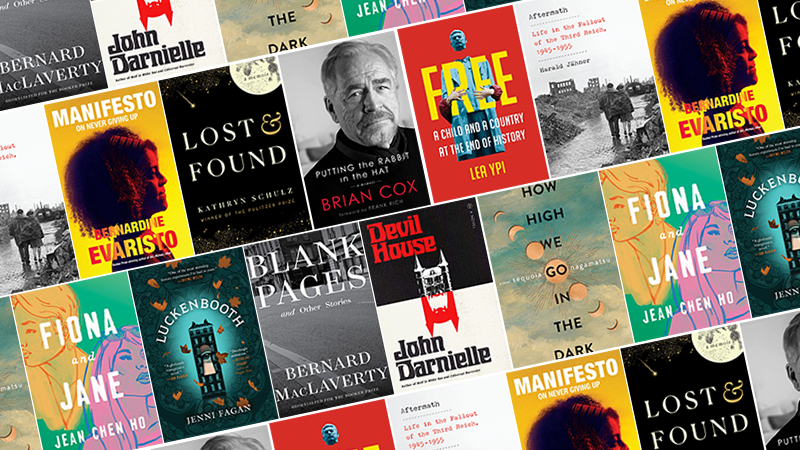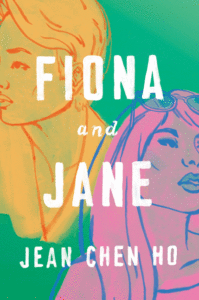
John Darnielle’s Devil House, Brian Cox’s Putting the Rabbit in the Hat, Bernardine Evaristo’s Manifesto, and Sequoia Nagamatsu’s How High We Go in the Dark all feature among the Best Reviewed Books of the Month.
Brought to you by Book Marks, Lit Hub’s “Rotten Tomatoes for books.”
*
1. Blank Pages by Bernard MacLaverty
(W. W. Norton)
10 Rave • 1 Positive • 1 Mixed
Read a story from Blank Pages here
“… a deft and life-affirming collection by a master of the form … The 12 stories in the new book are centred on the Belfast writer’s age-old preoccupations: love, loss, endurance, resilience, war, violence, the toxicity of perceiving human beings as ‘other’. They are bright bullets that lodge, written in spare but achingly accurate prose. MacLaverty is known for his precision and the realistic details that bring his stories so memorably to life. Many times during the collection I wondered how he came upon certain details, that seem, cumulatively, to be beyond the imagination of the writer, beyond research or Google … The range of the collection is remarkable. Different eras and backdrops abound, each one told with aplomb … soft touches of humour appear throughout … a gem of a collection that fully immerses from beginning to end.”
–Sarah Gilmartin (The Irish Times)

2. How High We Go in the Dark by Sequoia Nagamatsu
(William Morrow)
9 Rave • 4 Positive • 1 Mixed • 1 Pan
Read an excerpt from How High We Go in the Dark here
“If you’re a short-story lover—as I am—you’ll be impressed with Nagamatsu’s meticulous craft. If you crave sustained character and plot arcs, well, you’ll have to settle for admiring the well-honed prose, poignant meditations and unique concepts. Hardly small pleasures … The reader might best approach the book like a melancholy Black Mirror season … This is a lovely though bleak book. Humanity has long turned to humor in our darkest moments, but levity feels absent even in a chapter narrated by a stand-up comedian. That said, the somber tone unifies the disparate characters and story lines … a welcome addition to a growing trend of what we might call the ‘speculative epic’: genre-bending novels that use a wide aperture to tackle large issues like climate change while jumping between characters, timelines and even narrative modes … Nagamatsu squarely hits both the ‘literary’ and ‘science fiction’ targets, offering psychological insights in lyrical prose while seriously exploring speculative conceits … a book of sorrow for the destruction we’re bringing on ourselves. Yet the novel reminds us there’s still hope in human connections, despite our sadness.”
–Lincoln Michel (The New York Times Book Review)
3. Devil House by John Darnielle
(MCD)
8 Rave • 4 Positive
Read an excerpt from Devil House here
“… terrific: confident, creepy, a powerful and soulful page-turner. I had no idea where it was going, in the best possible sense … The thing about Darnielle’s writing, in all its forms, is this: If you’re that dorky outcast kid drawing a pentagram on the back page of your three-ring binder in algebra class, not because you want to drink anyone’s blood but because you think it’s cool, he sees you. His novels are in close contact with the alternative cultural universes of fantasy and the occult and science fiction, yet they don’t resemble genre fiction. They’re earthy and fly low to the ground. They are plain-spoken and in no hurry … Devil House…[is]never quite the book you think it is. It’s better.”
–Dwight Garner (The New York Times)

4. Fiona and Jane by Jean Chen Ho
(Viking)
8 Rave • 3 Positive
Read an excerpt from Fiona and Jane here
“… even to those not from Los Angeles, Ho’s debut collection feels like a shared experience, carefully read back to you … While Ho, born in Taiwan and raised in California, circles sexuality, money and religion with grace, the most moving parts of the book are about the two women’s respective family roots … Certain descriptions feel overdone and stilted … But regardless, over the course of the book Fiona and Jane become real and electric and precious people. The stories move through intimate, cinematic scenes … The world Ho creates between the two women feels like one friend reading the other’s story, wishing she were there … it is through compassion that the characters belong like this to each other, and to the reader, too.”
–Tammy Tarng (The New York Times Book Review)
5. Luckenbooth by Jenni Fagan
(Pegasus)
8 Rave • 2 Positive • 1 Mixed
“… a cabinet of curiosities that is both a love letter to the Scottish capital, and a knife to its throat … Fagan…has a ferocious empathy for her ootlins [outsider characters] and their struggles in a society that rejects and oppresses them … Occasionally, her characters feel slightly too modern in their thinking, too prescient of the world to come … like all the characters, Burroughs is so richly drawn, so enjoyable to be with, that you can forgive the authorial slips. Certainly, it’s not ahistorical to believe that society’s outcasts had a keen understanding of how they’ve had to make their own ways of being, find their own ways to be seen … the author…shifts between these voices with fevered joy, taking us through a host of characters who are all extravagant, wild and wounded at heart … Filled with blistering social critique, Luckenbooth is an ambitious and ravishing novel that will haunt me long after. Stories can be like a house, somewhere you can inhabit for a while. The best kind leave behind a room inside you.”
–Lauren Beukes (The New York Times Book Review)
**
1. Free: A Child and a Country at the End of History by Lea Ypi
(W. W. Norton & Company)
12 Rave • 2 Positive
Read an excerpt from Free here
“The book is packed with insights, on family as much as on politics. Ypi is a beautiful writer and a serious political thinker, and in just a couple hundred readable pages, she takes turns between being bitingly, if darkly, funny and truly profound … On one level, Free is a classic, moving coming-of-age story: A girl becomes a woman, a family struggles through hardship. The book’s intimacy comes in part from Ypi’s childhood diary, which she draws from to recount memories of classrooms and first crushes and teen angst. Her parents and the grandmother who helped raise her are her main characters, lovingly and vividly described. They have stuck with me. It helps that there’s a universality to the family.”
–Max Strasser (The New York Times Book Review)
2. Aftermath: Life in the Fallout of the Third Reich, 1945-1955 by Harald Jähner, tr. by Shaun Whiteside
(Knopf)
7 Rave • 6 Positive • 1 Mixed
.. a scholarly masterpiece which is also a good read … The material is as grim as can be imagined, and Jähner pulls no punches. But he doesn’t allow his story to degenerate into a catalogue of horrors. Instead, we are offered anecdotes and incidents, each memorable, many illustrated by newly discovered photographs, which build into a history which reads like a prelude to Waiting for Godot, that great work of 1949. In vignette after vignette, people remain people, however apocalyptic the events they have just participated in or witnessed or had visited upon them.”
–James Hawes (The Spectator)
3. Manifesto: On Never Giving Up by Bernardine Evaristo
(Grove Press)
10 Rave • 4 Positive
Read an excerpt from Manifesto here
“Throughout, the book deftly combines the personal and the political … Intersectionality runs through this book like a quiet but mighty river. I particularly enjoyed the stories about the 1960s, 1970s and early 1980s, including the underground queer subculture. These are all influences that have shaped the course of Evaristo’s life and the depth of her literary vision … Diversity is treasured in this book but there is an equal emphasis on equality and inclusion…She does not shy away from difficult debates on who has the right to tell which story … a beautiful, thoughtful and honest book about never giving up, even when it feels like you are ‘writing into a void’. It is also a meditation on personal transformation, cultural inequalities, activism, belonging, love and friendships—and above all, the power of creativity.”
–Elif Shafak (The New Statesman)
4. Lost & Found by Kathryn Schulz
(Random House)
8 Rave • 3 Positive
Listen to an interview with Kathryn Schulz here
“Schulz’s mind flows beautifully on the page. While this book is classified as a memoir, it can also be read as a sweeping set of essays. Schulz’s prose is lucid and intentional, yet unexpected and compassionate. She doesn’t race to make her point and that expansive pace is what makes this book such a pleasure. Hers is a nimble and profoundly humane mind, capable of carrying the various threads of her thinking onward without losing the integrity of the fabric she’s creating … Schulz uses her life’s stories as a launching point for an omnivore’s exploration of science, space, history, art, and writing in order to elaborate her points. Rather than dwell on her personal life, weighing the reader down with the operatic twists of some memoirs, Schulz treads lightly on the drama of her days. She’s not writing for her own personal catharsis … While this memoir is no quest for healing or a chronicle of family secrets, there is great weight in Schulz’s most personal moments. Being privy to her budding romance is a window into intense tenderness and deep gratitude … Where other memoirs concentrate on facts and family history, Schulz finds a way to subvert the genre, taking it to philosophical levels while maintaining a grounded intimacy.”
–Lauren LeBlanc (The Boston Globe)
5. Putting the Rabbit in the Hat by Brian Cox
(Grand Central)
4 Rave • 6 Positive • 2 Mixed
“Brian Cox has produced one of the funniest, most rip-roaring, irreverent and candid showbusiness memoirs this season, full of lively mockery … Cox has a wonderful eye and ear for the absurd … Cox’s book is like a transcription of a pub or after-dinner monologue: clever, perceptive, wandering back and forth chronologically … Cox hops from subject to subject, amplifying themes, picking up where he left off. There are lots of asides and digressions, as in the best talk. ‘We touched on it before’ is a typical phrase. It is loose, baggy, brilliant.”
–Roger Lewis (The Times)

